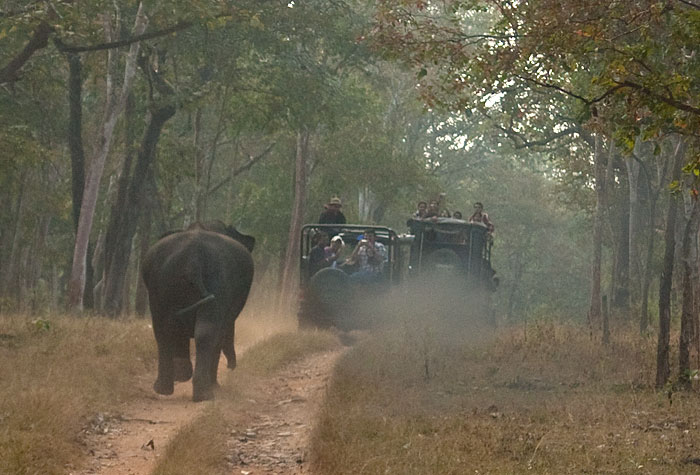Wildlife or Nature-based tourism is growing in many countries across the world including India. Krithi K. Karanth and Ruth DeFries examine trends and practices in wildlife tourism for ten parks across India. These are results of their study from the forthcoming paper in the journal, Conservation Letters.
Study Sites in India
Ten parks were selected across India – Ranthambore, Sariska, Pench, Kanha, Anshi-Dandeli, Bhadra, Nagarahole, Bandipur, Periyar and Mudumalai. These protected areas vary in tourist numbers, access to cities, and publicity, as well as local people and ecological conditions.
Methods
In 2009, interviews were conducted with ninety-one percent (336) of the tourist resorts and homestays around these ten parks. Interviews were also conducted with forest department officials and other relevant knowledgeable sources.
The Results
- Wildlife tourism is growing rapidly in India ~ average growth rate is 15% in the ten selected parks. Tourist numbers range from more than 5000 people per year in Bhadra to more than 500,000 people per year in Periyar. In eight parks, there was a positive annual growth rate except for Sariska and Bandipur.
- The majority (80%) of tourists visiting parks are Indian and this provides a tremendous opportunity to engage the Indian public in conservation. In nine parks the majority of tourists were Indian, except in Ranthambore where there were more international visitors.
- Tourist facilities include resorts and homestays, are largely privately owned and new with 72% of tourist facilities established after 2000, and 85% located within 5 km of the park boundaries. In Periyar, Ranthambore, Kanha and Pench the facilities are clustered together and this might help in monitoring practices and use of local resources.
- Tourist facilities use local resources heavily, especially water and fuel wood. Water sources were underground wells and public water supply. In some parks such as Ranthambore, Kanha and Pench, where there is severe water shortage in the summer months, tourist facilities had flowing water fountains and swimming pools.
- Local people are employed by facilities, but the jobs are mainly seasonal and the number of people who benefit directly is small.
- Land use outside the parks is rapidly changing and impacting wildlife movement. Land on the edge of the parks is being purchased by outsiders to construct new tourist facilities. Land prices are going up rapidly. In some parks, construction of walls and facilities are obstructing wildlife movement. Local people are selling to outsiders and moving further away from the park.
- Rules for entry of people and vehicles vary across the parks and depend largely on the forest officer in charge. In some parks only forest department vehicles are allowed and in others private vehicles enter the park. There is heavy vehicular traffic, for example more than 27,000 vehicles entered Kanha in 2007-2008 and tourism routes are long (2200km in Kanha).
- Reasons for growth in tourism include good wildlife sightings, increased publicity and marketing, particularly for tigers and parks like Ranthambore and Kanha, easy access to many cities, improvements in facilities and tourist activities.
- Existing guidelines and regulations for managing tourism, land and resource use are inadequate and need to be consistent for Indian parks.
- Tourist facilities support park managers on many issues including reporting of wildlife offences and patrolling efforts.
- Tiger shows are being widely promoted in Kanha and Pench. The opportunity to see tigers is increasingly becoming the sole motivation for tourists to visit these parks.
- Tourism revenue varies from more than $5000 to $3,000,000. In some parks such as Ranthambore, Periyar and Kanha tourism related revenue can potentially support park management efforts if used wisely.
- Carrying capacities for the number of tourists and vehicles that Indian parks can support has to be determined scientifically.
Wildlife Tourism in India: Pros and Cons?
Wildlife or nature-based tourism has been promoted as a conservation win-win as it can generate funds to support park management and local communities, and increase public support for conservation. However, several studies show that unplanned tourism can harm and add to existing conservation challenges in parks, and may benefit very few people.
The growth in wildlife tourism in India presents an important opportunity to engage both rural and urban Indians in conservation issues and can, for some parks, provide substantial revenues. Tourism however is not regulated and there is an urgent need to establish both best practice guidelines and regulations to manage tourists, tourist facilities, use of land, water and other resources around Indian parks.
Co-author Ruth DeFries: Ecology, Evolution, and Environmental Biology, Columbia University, New York, NY 10027, USA


 CI is a non-profit, non-commercial portal that aims to facilitate wildlife and nature conservation by providing reliable information and the tools needed to campaign effectively.
CI is a non-profit, non-commercial portal that aims to facilitate wildlife and nature conservation by providing reliable information and the tools needed to campaign effectively.